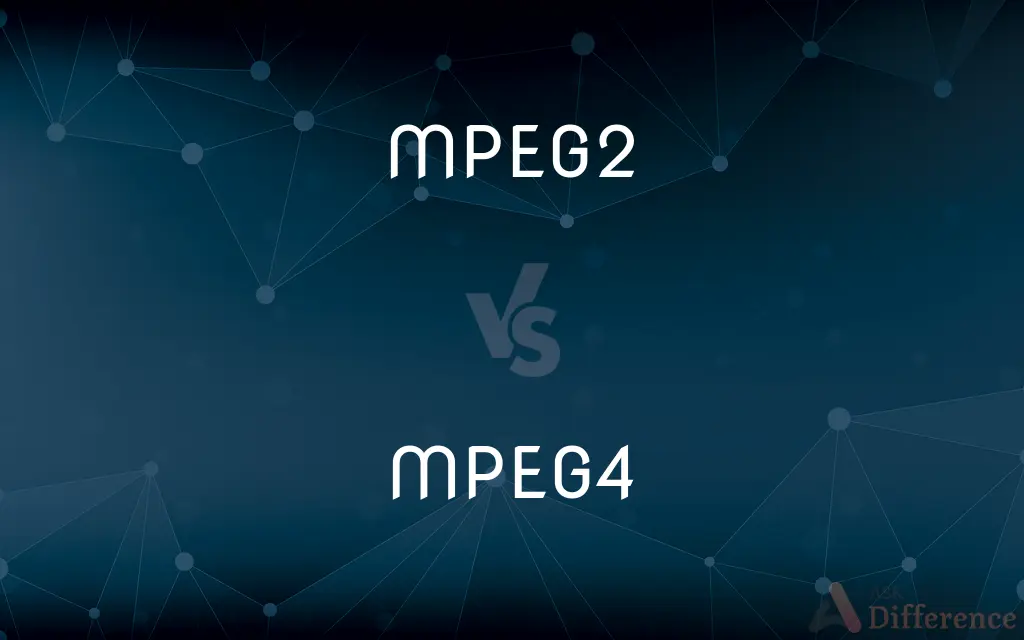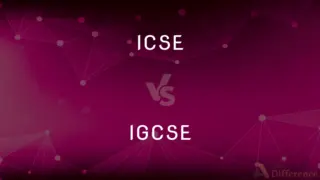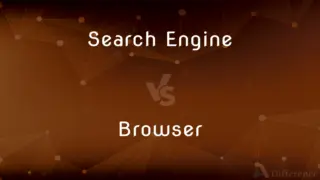MPEG2 vs. MPEG4 — What's the Difference?
By Tayyaba Rehman — Published on January 22, 2024
MPEG2 is an older standard mainly used for TV broadcasting and DVDs with high bandwidth, while MPEG4 is a newer, more efficient standard supporting low bandwidth multimedia applications.

Difference Between MPEG2 and MPEG4
Table of Contents
ADVERTISEMENT
Key Differences
MPEG2, developed by the Moving Picture Experts Group, is an older digital video compression standard known for its use in digital television and DVDs. MPEG4, a later development by the same group, offers higher compression and is used extensively in internet streaming and mobile communications.
MPEG2 excels in maintaining video quality at high bandwidths, making it suitable for traditional broadcasting. MPEG4, with advanced compression techniques, is more efficient, allowing for quality video at lower bitrates, which is ideal for streaming and online video content.
Compatibility-wise, MPEG2 is widely supported in older systems and set-top boxes, while MPEG4, due to its newer technology, requires more modern hardware and software for decoding and playback.
MPEG2 is less efficient in terms of file size compared to MPEG4. MPEG4 files are significantly smaller, offering the same quality at a fraction of the size, beneficial for storage and streaming.
While MPEG2 is focused mainly on video compression, MPEG4 is a multimedia standard that not only compresses video but also supports features like 3D graphics, interactive elements, and digital rights management.
ADVERTISEMENT
Comparison Chart
Usage
Digital TV, DVDs
Internet streaming, mobile communications
Bandwidth Efficiency
High bandwidth, less compression
Lower bandwidth, higher compression
Compatibility
Widely supported in older systems
Requires modern hardware for decoding
File Size
Larger due to less compression
Smaller, more efficient in space
Features
Primarily video compression
Supports video, 3D graphics, DRM, interactivity
Compare with Definitions
MPEG2
MPEG2 maintains quality at high bandwidths.
The satellite broadcast was in MPEG2, ensuring high-quality video.
MPEG4
MPEG4 includes features like 3D graphics and DRM.
The interactive game was developed using MPEG4's 3D capabilities.
MPEG2
MPEG2 is less efficient than modern compression standards.
We're converting our MPEG2 archives to a more efficient codec.
MPEG4
MPEG4 is a multimedia encoding standard for digital video and audio.
The online video was streamed in MPEG4 format.
MPEG2
MPEG2 is a standard for video and audio compression.
The DVD used MPEG2 format for its video content.
MPEG4
MPEG4 is efficient for streaming and internet applications.
Our website uses MPEG4 to ensure smooth video playback.
MPEG2
MPEG2 files are larger compared to newer codecs.
The MPEG2 file took up more space on my hard drive.
MPEG4
MPEG4 supports lower bandwidths and smaller file sizes.
The MPEG4 compression reduced the file size significantly.
MPEG2
MPEG2 is known for its use in broadcasting and DVDs.
Most of our DVD collection is encoded in MPEG2.
MPEG4
MPEG4 is suited for modern, high-definition content.
The smartphone records video in high-definition MPEG4.
Common Curiosities
Can MPEG2 handle high-definition video?
Yes, but MPEG2 requires more bandwidth and larger file sizes for high-definition compared to MPEG4.
Is MPEG4 compatible with older DVD players?
No, most older DVD players are designed to support MPEG2, not MPEG4.
What is the primary use of MPEG2?
MPEG2 is primarily used for digital TV broadcasting and DVDs.
Does MPEG4 offer better video quality than MPEG2?
MPEG4 can provide similar or better quality at a lower bitrate, making it more efficient, especially for high-definition content.
Why is MPEG4 preferred for internet streaming?
MPEG4's higher compression efficiency makes it suitable for low bandwidth streaming.
Can MPEG4 support interactive content?
Yes, MPEG4 supports interactive elements and 3D graphics, unlike MPEG2.
Is MPEG2 still used today?
Yes, MPEG2 is still used, particularly in contexts like broadcasting where compatibility with older systems is important.
Do MPEG4 files require more processing power to play?
Yes, MPEG4 files often require more processing power for decoding due to their complex compression techniques.
Are MPEG2 and MPEG4 compatible with each other?
They are not directly compatible as they use different compression techniques and standards.
Can MPEG4 be used for professional video editing?
Yes, MPEG4 can be used for professional video editing, especially where file size and bandwidth are concerns.
Are MPEG2 files larger than MPEG4 files?
Yes, MPEG2 files are typically larger due to less efficient compression.
Is MPEG4 good for mobile devices?
Yes, MPEG4 is ideal for mobile devices due to its high compression efficiency and lower bandwidth usage.
Does MPEG4 support digital rights management (DRM)?
Yes, MPEG4 includes support for DRM, making it suitable for protected content distribution.
Is MPEG2 adequate for 4K video?
MPEG2 can support 4K video, but it's not as efficient as MPEG4, resulting in much larger file sizes.
Can MPEG2 be used for online streaming?
While possible, MPEG2 is less suitable for streaming due to its larger file size and higher bandwidth requirements.
Share Your Discovery

Previous Comparison
ICSE vs. IGCSE
Next Comparison
Search Engine vs. BrowserAuthor Spotlight
Written by
Tayyaba RehmanTayyaba Rehman is a distinguished writer, currently serving as a primary contributor to askdifference.com. As a researcher in semantics and etymology, Tayyaba's passion for the complexity of languages and their distinctions has found a perfect home on the platform. Tayyaba delves into the intricacies of language, distinguishing between commonly confused words and phrases, thereby providing clarity for readers worldwide.
















































